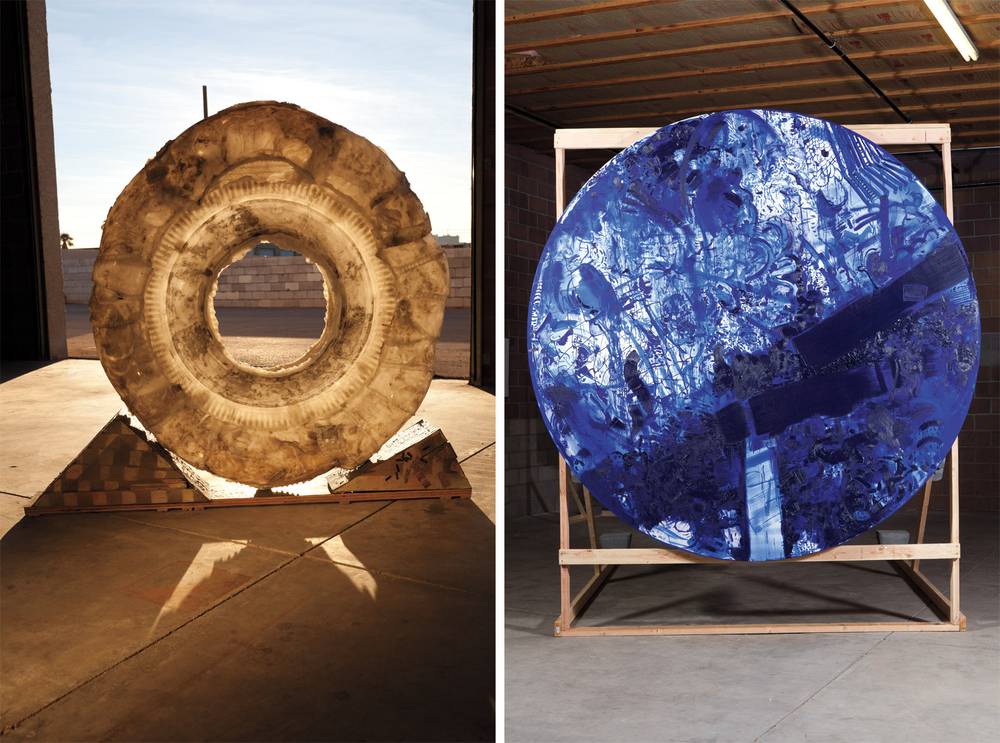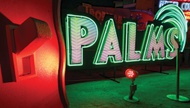
1 Is the Zero That Comes Before Through February 1; Saturday, noon-4 p.m., and by appointment. Vast Space Projects, 727 Susanna Way, 323-240-2888.
1 Is the Zero That Comes Before is the title of Nicolas Shake’s haunting exhibition of paintings, sculptures and photo collages at Vast Space Projects’ latest Henderson location. The title’s 1/0 refers to binary code—either something exists (1) or it doesn’t (0). Shake brings the now-you-see-it, now-you-don’t phenomenon to his second solo exhibition. Emptiness and fullness, presence and absence, object and subject toggle back and forth in the mind and eyes.
Having room to maneuver helps. The 5,000-foot Vast warehouse, with its 20-plus-foot ceilings, is a Moby Dick of a space, as “vast” as the name implies. To keep his work from being swallowed up, Shake constructed easels and armatures to display paintings, lugged a ready-made faux-concrete lump from LA streets, erected a “wall” from his studio and positioned skate-ramp photo collages and “Friendly Plastic” sculptures in the main space. A video interview with the artist runs in a cozy office room, while a single desert photograph—one of the stunning series that inaugurated Shake’s career—hangs in the reception area.
Shake began by building installations of found objects in the desert and recording them in sensual photos that riff on the apocalyptic transience of our lives: the crashed housing market, jettisoned consumer goods, wrecked cars. Salvage archeology literally imprints 1 Is the Zero. Impressions of grocery carts and tires, made of the thinnest layers of Friendly Plastic, literally transport detritus from the scruffy fringes of Palmdale into the warehouse. The fragile materials, pale cream colors and delicate threads summon missing objects almost like ghosts. It’s not the “1” of materiality or the “0” of nonexistence, but somewhere in between—tender representations that verge on disappearing into the suburban wasteland from which they came.
The godforsaken desert of civilization haunts the paintings, too. From small 32-inch by 24-inch works to a 9-feet-in-diameter disk, the canvases maintain the binary, with rectangles (1) and circular (0) shapes. More monochromic than Shake’s earlier work, they’re covered with scratches and smears, tire-tread pileups of paint, snippets of chain-link texture and gestural, layered brushwork. The striking, gray-scale “Walking Through the Ashes,” incorporates bits of Shake’s photos in a round, mixed-media canvas that affectionately transforms an ephemeral patch of trashed-out desert into a radar map of feeling. In a meeting of the elements, “Diminishing Monolith” recalls the strange opacity of color in the deep Mojave sky at the same time it summons the tattered desert floor.
But the 1/0 theme is most explicit in “This Is the Place,” a site-specific photo collage incorporating cut-up photos and the warehouse wall. The eye fills in the missing middle of the work, framing the wall in an imaginary rectangle. Touché. It’s there, if you really look.




